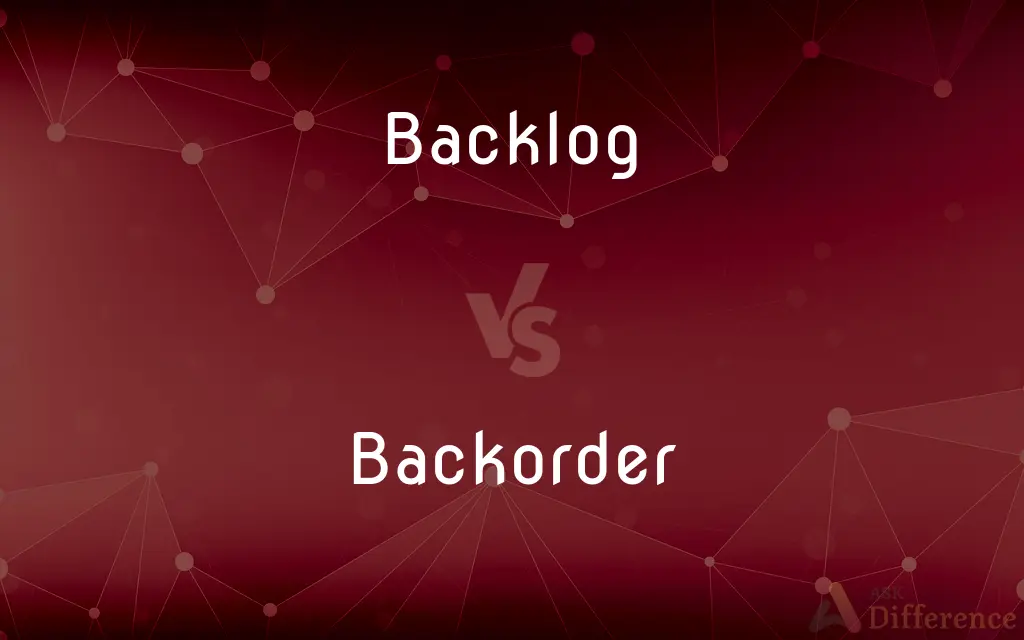Backlog vs. Backorder — What's the Difference?
By Tayyaba Rehman & Fiza Rafique — Updated on April 2, 2024
A backlog refers to accumulated work or orders yet to be completed, while a backorder is a specific order that cannot be fulfilled due to lack of inventory but is still requested by a customer.

Difference Between Backlog and Backorder
Table of Contents
ADVERTISEMENT
Key Differences
A backlog represents an accumulation of work or orders that have been received but not yet executed or completed. This can apply to various contexts, from manufacturing processes, where products are yet to be made, to service industries, where services are yet to be rendered. The term often indicates a delay or pending status of tasks that need attention. On the other hand, a backorder specifically refers to orders for products that a business cannot fulfill immediately due to insufficient inventory. Unlike general backlogs, backorders are a clear signal of demand exceeding supply, typically for a particular item, and they require the business to reorder or produce more to meet customer requests.
In terms of impact, a backlog might affect a company's operational efficiency and customer satisfaction negatively if it signifies a chronic inability to meet demand or manage tasks efficiently. It necessitates strategic planning to clear the backlog without compromising quality. Conversely, backorders, while also indicating a gap between supply and demand, can signal strong market demand for a product. Managing backorders effectively involves balancing inventory restocking with ongoing demand to minimize customer wait times and maintain satisfaction.
Backlogs can be seen as a broader term encompassing any accumulated work, including administrative tasks, project developments, or production. They require a comprehensive approach to prioritize and address the accumulated tasks efficiently. Backorders are more specific and often require immediate attention to inventory management, supplier relations, and customer communication to ensure that demand is met as quickly as possible without losing sales or harming customer relationships.
Strategies to manage a backlog may include increasing production capacity, prioritizing tasks based on urgency, or outsourcing. To handle backorders, companies might expedite reordering processes, offer alternatives to customers, or improve their inventory forecasting methods. Both situations call for transparent communication with stakeholders about expected timelines and efforts being made to resolve the issue.
While both backlogs and backorders involve delays and pending tasks, they differ in scope and management strategies. A backlog is more about the volume of work pending across various areas of a business, whereas a backorder is a direct indicator of product demand not currently being met due to inventory shortages. Effective management of both is crucial for maintaining operational efficiency and ensuring customer satisfaction.
ADVERTISEMENT
Comparison Chart
Definition
Accumulated work or orders yet to be completed.
Specific orders that cannot be fulfilled due to lack of inventory.
Context
Can apply to any pending tasks, including services and production.
Specifically related to product orders and inventory management.
Indicator of
Operational efficiency and workload management.
Demand exceeding supply for specific products.
Management Focus
Prioritizing and efficiently clearing accumulated work.
Replenishing inventory to meet specific customer orders.
Impact
Affects overall efficiency and customer satisfaction if prolonged.
Signals strong demand but can lead to customer dissatisfaction if not managed well.
Strategies
Increasing capacity, task prioritization, outsourcing.
Expedited reordering, offering alternatives, improving forecasting.
Compare with Definitions
Backlog
Accumulated unfinished work or orders.
The software company is working weekends to clear the development backlog.
Backorder
Customer requests awaiting inventory replenishment.
The latest book release is on backorder due to unexpected demand.
Backlog
A queue of pending tasks or projects.
The marketing team has a backlog of ad campaigns to launch.
Backorder
Orders delayed due to unavailable stock.
Popular smartphone models are on backorder until next month.
Backlog
Delays in service or product delivery.
The repair service has a two-week backlog due to high demand.
Backorder
A sign of product demand surpassing supply.
High-end graphics cards are frequently on backorder.
Backlog
The buildup of work needing completion.
The production plant is addressing a backlog of unfulfilled orders.
Backorder
The process of selling products not currently in stock.
The store accepts backorders for specialty items.
Backlog
Overdue assignments or responsibilities.
There’s a backlog of customer inquiries needing responses.
Backorder
Situations requiring supplier restocking.
Essential components for manufacturing are on backorder, delaying production.
Backlog
A reserve supply or source.
Backorder
An order that cannot be currently filled or shipped, but is requested nonetheless for when the item becomes available again.
Backlog
An accumulation, especially of unfinished work or unfilled orders.
Backorder
To place such an order
Backlog
A large log at the back of a fire in a fireplace.
Backlog
To acquire (something) as a backlog.
Backlog
To become a backlog; accumulate.
Backlog
A large log to burn at the back of a fire.
Backlog
A reserve source or supply.
Backlog
An accumulation or buildup, especially of unfilled orders, unconsumed products or unfinished work.
He went to work on Saturday to try to work through the backlog of papers on his desk.
Kyle purchased a new one despite having a backlog of video games that he hasn't played.
Backlog
A log containing text previously read, as in text-based video games or chat rooms.
Backlog
To acquire something as a backlog, or to become a backlog
Backlog
A large stick of wood, forming the back of a fire on the hearth. Contrasted to forestick.
There was first a backlog, from fifteen to four and twenty inches in diameter and five feet long, imbedded in the ashes.
Backlog
An accumulation (of tasks or of materials) that were not performed or processed at the normal time and require attention; as, unexpected demand led to a large backlog of unfilled orders; politically motivated delays led to a large backlog of unconfirmed judicial appointments.
Backlog
An accumulation of jobs not done or materials not processed that are yet to be dealt with (especially unfilled customer orders for products or services)
Backlog
Large log at the back of a hearth fire
Backlog
Something kept back or saved for future use or a special purpose
Backlog
Accumulate and create a backlog
Common Curiosities
What causes a backlog?
A backlog can be caused by several factors, including increased demand, insufficient resources, or operational inefficiencies.
How can a backorder affect customer satisfaction?
While a backorder indicates strong demand, it can lead to customer frustration and dissatisfaction if not managed promptly and communicated effectively.
What's the difference in managing a backlog vs. a backorder?
Managing a backlog involves prioritizing and efficiently clearing accumulated tasks, while managing backorders focuses on quickly replenishing inventory to fulfill specific orders.
Is it better to have a backlog or backorders?
Neither is ideal, but both situations require different management strategies and can offer insights into demand and operational efficiency.
Can backorders be prevented?
While difficult to eliminate entirely, effective inventory management and forecasting can significantly reduce the occurrence of backorders.
What steps can companies take to reduce backorders?
Improving supplier relationships, better demand forecasting, and maintaining safety stock are strategies to reduce backorders.
Can a backlog lead to backorders?
Yes, if the backlog involves delayed production or restocking, it can result in backorders for the affected products.
Are backlogs always a negative indicator?
Not necessarily. While prolonged backlogs can indicate problems, a manageable backlog may simply reflect a high volume of business or temporary delays.
How do companies prioritize tasks in a backlog?
Prioritization can be based on urgency, customer impact, revenue potential, or strategic importance to the company.
How do businesses communicate backorder situations to customers?
Transparent communication, including expected wait times and offering alternatives, can help manage customer expectations during backorder situations.
Can technology help manage backlogs and backorders?
Yes, inventory management systems, project management software, and customer relationship management platforms can help address and prevent backlogs and backorders.
How do customers typically react to backorders?
Customer reactions can vary from patience, provided they are informed and given an estimated wait time, to frustration and seeking alternatives elsewhere.
Are backorders a sign of poor planning?
Not always. While they can result from forecasting errors, backorders can also arise from unforeseen spikes in demand or supply chain disruptions.
What industries are most affected by backlogs and backorders?
Manufacturing, retail, and service industries, particularly those dealing with physical products, are commonly affected.
How long does it take to clear a backlog?
The time to clear a backlog varies widely depending on its size, the availability of resources, and the specific strategies implemented.
Share Your Discovery

Previous Comparison
Flock vs. Gaggle
Next Comparison
Lifter vs. SpatulaAuthor Spotlight
Written by
Tayyaba RehmanTayyaba Rehman is a distinguished writer, currently serving as a primary contributor to askdifference.com. As a researcher in semantics and etymology, Tayyaba's passion for the complexity of languages and their distinctions has found a perfect home on the platform. Tayyaba delves into the intricacies of language, distinguishing between commonly confused words and phrases, thereby providing clarity for readers worldwide.
Co-written by
Fiza RafiqueFiza Rafique is a skilled content writer at AskDifference.com, where she meticulously refines and enhances written pieces. Drawing from her vast editorial expertise, Fiza ensures clarity, accuracy, and precision in every article. Passionate about language, she continually seeks to elevate the quality of content for readers worldwide.














































